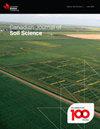Soil responses to inclusion of corn, soybean, and cover crops under rainfed conditions in the northern Great Plains
IF 1.5
4区 农林科学
Q4 SOIL SCIENCE
引用次数: 0
Abstract
Crop rotations in the northern Great Plains of North America increasingly include corn ( Zea mays L.) and soybean ( Glycine max (L.) Merr.). Use of cover crops, while less extensive, is also increasing given their purported agronomic and environmental benefits. To date, soil responses to the inclusion of corn, soybean, and cover crops in rainfed cropping systems have not been well documented in the region. Therefore, soil properties were evaluated 6 years after establishment of three crop rotations (spring wheat ( Triticum aestivum L.)–soybean (SW–S), spring wheat–corn–soybean (SW–C–S), and spring wheat–corn–cover crop (SW–C–cc)) each split by no and minimum tillage on a Dark Brown Chernozem near Mandan, ND, USA. Soil responses to treatments were subtle and exclusive to the 0–7.6 cm depth. Soil pH was lower in SW–S than SW–C–cc (5.28 vs. 5.48; P = 0.05), SO4-S was greater under SW–C–cc than SW–C–S (13.4 vs. 11.6 g S kg−1; P = 0.03), exchangeable K was greater under SW–C–S and SW–C–cc than SW–S (0.83 cmol kg−1 vs. 0.52 cmol kg−1; P = 0.05), and water-stable aggregates were greater in SW–S than SW–C–S (26% vs. 19%; P = 0.08). Soil organic carbon (SOC) and total N did not differ among crop rotations or between tillage treatments, while particulate organic matter N was greater under no tillage compared to minimum tillage ( P = 0.08). Between 2012 and 2018, soil pH decreased and SOC increased under SW–C–S. Frequent monitoring of near-surface soil conditions in rotations with soybean every other year is recommended. Furthermore, innovative management practices are needed to enhance soil C and N fractions in rotations with full-season cover crops.大平原北部雨养条件下土壤对玉米、大豆和覆盖作物的反应
北美北部大平原的轮作作物越来越多地包括玉米(Zea mays L.)和大豆(Glycine max (L.) Merr.)。虽然覆盖作物的使用范围较小,但由于其所谓的农艺和环境效益,其使用也在增加。迄今为止,在该地区的雨水灌溉种植系统中种植玉米、大豆和覆盖作物对土壤的影响还没有很好的记录。因此,在美国北达科他州曼丹附近的暗褐色切尔诺泽姆(Dark Brown Chernozem)上,对三种轮作(春小麦-大豆(SW-S)、春小麦-玉米-大豆(SW-C-S)和春小麦-玉米-覆盖作物(SW-C-cc))建立 6 年后的土壤特性进行了评估。土壤对处理的反应很微妙,且只限于 0-7.6 厘米的深度。土壤 pH 值在 SW-S 中低于 SW-C-cc(5.28 vs. 5.48;P = 0.05),SO4-S 在 SW-C-cc 中高于 SW-C-S(13.4 vs. 11.6 g S kg-1;P = 0.03),SW-C-S 和 SW-C-cc 的可交换钾高于 SW-S(0.83 cmol kg-1 vs. 0.52 cmol kg-1;P = 0.05),SW-S 的水稳团聚体高于 SW-C-S(26% vs. 19%;P = 0.08)。土壤有机碳(SOC)和全氮在不同轮作或不同耕作处理之间没有差异,而颗粒有机质氮在免耕条件下比最小耕作条件下多(P = 0.08)。2012 年至 2018 年间,SW-C-S 下土壤 pH 值下降,SOC 增加。建议每隔一年对与大豆轮作的近表层土壤条件进行频繁监测。此外,还需要创新的管理方法来提高全季覆盖作物轮作中的土壤碳和氮组分。
本文章由计算机程序翻译,如有差异,请以英文原文为准。
求助全文
约1分钟内获得全文
求助全文
来源期刊

Canadian Journal of Soil Science
农林科学-土壤科学
CiteScore
2.90
自引率
11.80%
发文量
73
审稿时长
6.0 months
期刊介绍:
The Canadian Journal of Soil Science is an international peer-reviewed journal published in cooperation with the Canadian Society of Soil Science. The journal publishes original research on the use, management, structure and development of soils and draws from the disciplines of soil science, agrometeorology, ecology, agricultural engineering, environmental science, hydrology, forestry, geology, geography and climatology. Research is published in a number of topic sections including: agrometeorology; ecology, biological processes and plant interactions; composition and chemical processes; physical processes and interfaces; genesis, landscape processes and relationships; contamination and environmental stewardship; and management for agricultural, forestry and urban uses.
 求助内容:
求助内容: 应助结果提醒方式:
应助结果提醒方式:


